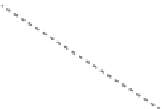Geoscience Reference
In-Depth Information
Fig. 1
Poles of reference and
time-dependent Earth orienta-
tion parameters with regard to
the coordinate systems TRS
and GCRS. Figure modified
from Mendes Cerveira et al.
(
2009
)
y
p
(t)
P
TRS
dUT1(t)
x
p
(t)
CIP
equator of the reference epoch. Assuming that all effects associatedwith the transition
between barycentric and geocentric system are taken into account, the transformation
from the TRS to the GCRS can be expressed as a series of time-dependent rotation
matrices (McCarthy and Luzum
2010
)
[
GCRS
]
=
Q
(
t
)
·
R
(
t
)
·
W
(
t
)
·
[
TRS
]
.
(1)
Herein,
W
describes polarmotion as calculated from
x
p
and
y
p
, which are the coor-
dinates of the intermediate system's reference pole, the CIP (
Celestial Intermediate
Pole
), in the Earth-fixed reference system. The argument of the spin component
matrix
R
(
t
)
is named
Earth Rotation Angle
(ERA) and directly relates to UT1. Pre-
cession and nutation are accounted for by the matrix
Q
(
t
)
based on the angles
X
and
Y
, which represent the coordinates of the CIP in the celestial reference system.
Within the framework of the transformation according to the IAU 2000 resolutions,
(
t
)
the set of
x
p
,
Y
constitutes the EOP, see the schematic description
displayed in Fig.
1
. If we deploy the old transformation concept based on ecliptic and
equator,
X
and
Y
need to be replaced by nutation in obliquity and longitude, usually
denoted as
y
p
,
dUT1
,
X
,
. For an extended discussion on the EOP and the transition as
defined in Eq. (
1
), refer to Seitz and Schuh (
2010
).
The aforementioned Celestial Intermediate Pole represents the reference pole to
which measurements of space geodetic techniques are related, and thus defines the
observed axis. This is a pure convention, which is realized by an accordingly adapted
precession-nutation theory. The direction towards the CIP does not correspond to any
physically defined axis, like the rotation axis, the figure axis or the angularmomentum
axis (Schuh and Böhm
2011
). Nevertheless, it is possible to connect it to each of
those axes.
As already indicated, the CIP can be viewed as intermediate pole that separates
the motion of the TRS-pole in the GCRS into a celestial part and a terrestrial part.
According to McCarthy and Luzum (
2010
), precession and nutation
Δε
and
Δψ
are con-
sidered as long-periodic motion of the CIP in the celestial reference frame within the
frequency range
{
X
,
Y
}
cpsd (cycles per sidereal day). With the minus sign
labeling retrograde motion (opposite to the sense of Earth rotation) and the plus sign
denoting prograde motion (in the sense of Earth rotation), all motions of the CIP in
the terrestrial frame outside the retrograde diurnal band
σ
c
∈
(
−
0
.
5
,
0
.
5
)
σ
t
∈
(
−
1
.
5
,
−
0
.
5
)
cpsd are
allocated to polar motion
x
p
,
y
p
(Schuh and Böhm
2011
). The given frequency



















